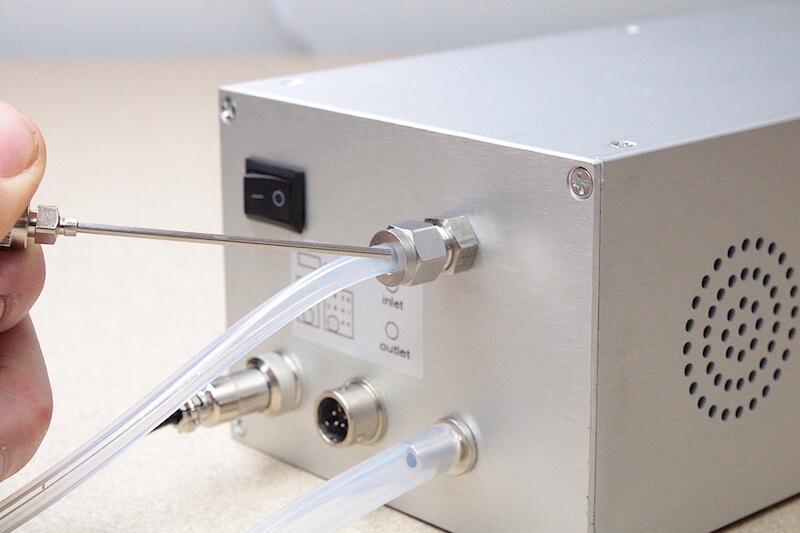Argon Leak Detector
Brand: FORENSICS DETECTORS
Model: FD-311-Ar
User Manual: Click Here
Blog Article: Click Here
Features




Specifications
Argon Gas (Ar): 0 - 100% with 0.1% resolution
Accuracy: ≤±2% F.S.
Response time: ≤ 20 sec
Display: High-Resolution Color LCD
Alarms: LED, sound, and vibration
Operating Temp & RH: 0F - 122F & <95% RH
Battery: DC3.7V Li-battery 2000 mAh
Working / Charging time: >6 hours / 4 hours
Sensor life: > 10 years
Protection category: IP65
Explosion Proof: Ex ib IIB T3 Gb
Dimension/Weight: 9.5 x 2.5 x 1.7inches, 440grams
Pump Flow: 0.5 LPM
Inlet Air Barb: 5mm diameter barb
Recharge: USB (5V @ 1A)
What do you get?
- Argon Analyzer (Argon Leak Detector)
- Li-ion Rechargeable Battery
- USB Charger and Cable
- 2-inch Needle Probe
- Color English Manual
- USA Technical Support
- USA NIST calibration certificate
- Hard Carry Case

Applications
- Science and R&D for Argon Leak Detection
- Inert Gas Purging and Argon Leak Detection
- Scuba and Technical Diving
- Chemical Reaction Analysis
- Heat Treatment Applications
- 3D Printing and Manufacturing
- Metal Processing
- Vacuum Equipment Operating
- Heat Treatment Processing
Best Argon Leak Detector?
This is a professional Argon Leak Detector by Forensics Detectors. Equipped with an advanced thermal conductivity sensor and a built-in pump. Comes factory-calibrated with a NIST traceability certificate. The detection range of Ar gas is 0 - 100% within 20 seconds at an accuracy of +/- 2% full-scale. Comes factory NIST calibrated from Los Angeles, CA. The detector has a DC3.7V Li-battery 2000mAh that allows for over 6 hours of continuous use. Includes advanced features such as high-resolution LCD, backlight high-resolution LCD, calibration features, and a built-in pump to draw your sample and increase response time and ensure constant pressure and flow for the most accurate Ar gas concentration readings.
Our Argon gas analyzer draws a continuous gas sample to analyze gas mixes for compressed gas, industrial applications, welding, leak detection, and research & development. It also comes with a probe and tubing to be used as an Argon gas point sampling gas leak analyzer used in various equipment including vacuum equipment, inert environments, heat treatment, welding, 3D Printing, metal processing, and manufacturing.

Why is Argon Used in Trace Gas Leak Detection?
Argon is used in trace gas leak detection for several reasons:
- Inertness: Argon is an inert gas, which means it does not readily react with other substances. It allows for accurate detection of leaks without introducing additional elements or contaminants.
- Non-Toxicity: Argon is non-toxic and non-reactive, posing minimal health and safety risks to personnel involved in leak detection activities.
- Availability and Cost: Argon is widely available and relatively affordable compared to some other trace gases (see helium).
- Versatility: While argon is commonly used for leak detection, it can also be employed in other applications such as inert gas purging, gas chromatography, and as a carrier gas in analytical instruments. This versatility adds to the appeal of using argon for trace gas leak detection since it can serve multiple purposes within an organization or facility.

Who Uses a Argon Leak Detector?
Common uses of an argon gas leak detector include:
- Industrial Facilities: Industries that handle or store large quantities of argon gas, such as manufacturing plants, metal fabrication shops, and chemical processing facilities, may employ argon gas leak detectors to ensure the safety and integrity of their systems.
- Welding and Metalworking: Argon gas is commonly used as a shielding gas in welding processes, particularly in Tungsten Inert Gas (TIG) welding and Metal Inert Gas (MIG) welding. Argon gas leak detectors are utilized to identify leaks in the welding equipment or associated gas supply systems.
- Laboratories R&D: Research laboratories and scientific facilities that work with argon gas, such as those involved in materials science, physics, or chemistry, may utilize argon gas leak detectors to monitor the gas handling systems and ensure safety measures are in place.
- Semiconductor Manufacturing: Argon gas is used in the semiconductor industry for various purposes, including the production of high-purity silicon wafers and as a carrier gas in chemical vapor deposition processes. Argon gas leak detectors are employed to maintain the purity of the gas supply and detect any leaks that could potentially impact the manufacturing process.
- Cryogenic Applications: Argon gas is utilized in cryogenic systems, such as in cryogenic storage facilities or superconducting magnets. Leak detection is crucial in these applications to prevent gas losses and maintain the integrity of the cryogenic environment.
What about Argon Gas Calibration?
Calibration of an argon leak detector is a technical process that should be performed every 6 to 12 months to ensure that your argon leak detector is functioning accurately. Over time, the argon sensor may drift and degrade, making it necessary to perform gas calibration to ensure accurate and repeatable measurements.
Gas calibration involves exposing the argon analyzer to a traceable concentration of test gas. We offer a calibration service for your convenience, but you may choose to calibrate the analyzer yourself. In that case, we provide a step-by-step calibration tutorial that you can follow. To perform the calibration, you will need the following items, traditionally called the calibration kit:
Calibration T-piece & Tubing
Calibration Gas (Ar)
Calibration Gas Regulator (C10)
What about Argon Bump Testing?
Ensuring the proper operation of your argon leak detector is crucial. To confirm its functionality and build confidence, it is recommended to perform an argon bump test. This involves exposing the argon analyzer to argon bump gas, which is sprayed at the input port to induce a positive response.
If you intend to purchase an argon gas bottle and regulator, there is no need to purchase a separate bump gas can as the argon gas bottle can be used as the bump gas source.
Any Extra Accessories Required?
All the accessories are listed below. The first three items are required for calibration, then we have a bump test can, then a analyzer stand. Lastly, we present the calibration service, which folks may wish to send then calibrating themselves.
Accessories:
Calibration T-piece & Tubing
Calibration Gas (Ar)
Calibration Gas Regulator (C10)
Bump Gas (Argon)
Gas Detector Stand
Gas Detector Calibration Service (single gas)
How do I use the Argon Gas Leak Detector?
Using the argon leak detector is a straightforward process.
- Begin by turning on the analyzer and allowing it to start operating after the countdown. If you plan to undertake leak detection, install the tubing and needle, taking care to ensure there are no blockages.
- Next, perform a quick bump test to ensure the analyzer is functional. Assuming the analyzer is within the calibration period, you are ready to proceed. However, if you are serious about maximum sensitivity and accuracy, it's best to get the unit calibrated.
- Once you have completed the bump test, take the probe and scan the area of interest, moving about 2 seconds per inch. Be patient and thorough to ensure you capture any leaking argon gas.
How Long Does the Argon Gas Sensor Last?
The Argon Leak Detector is equipped with a solid-state thermal conductivity sensor, which is good news as these sensors have a much longer lifespan than traditional electrochemical gas sensors. In fact, thermal conductivity sensors can last between 6 to 10 years, and sometimes even longer, whereas electrochemical gas sensors typically last only 2-3 years.
How Should I Store my Argon Gas Leak Detector?
To ensure maximum sensor life and accurate measurements upon operation, it is recommended to store the Argon Gas Leak Detector in a moderate environment with a humidity level of 50%RH and a room temperature of approximately 70F. The unit should be kept in the hard waterproof case it was sold with for optimal storage conditions.
Conclusion
- The Argon Leak Detector by Forensics Detectors is made to detect Argon leaks or to provide a quantitative Argon concentration reading.
- It is used for analyzing gas mixes, leak detection, and various applications in compressed gas, welding, research and development, and industrial settings.
- Argon gas analyzers require love. Just like most gas detectors, they must be calibrated on a regular basis to ensure accuracy. And bump tested for operational confidence.
- Argon leak detectors are also called argon gas sniffers, argon gas analyzers, and argon gas testers.
- Argon Gas Leak Detectors are not cheap. They are expensive items.
- Argon Gas Leak Detectors are a niche and exotic device. They are not purchased daily, so make sure you are well-educated and know exactly what you are getting.
Author
This article was written by me, Dr. Koz. I am the President of Forensics Detectors located in California, USA. I am a subject matter expert on gas sensor technology, gas detectors, gas meters, and gas analyzers. I have been designing, building, manufacturing, and testing toxic gas detection systems for over 20 years. I love Gas Detection and Brazilian Jiu Jitsu.
Email: drkoz@gasleakdetectors.com

